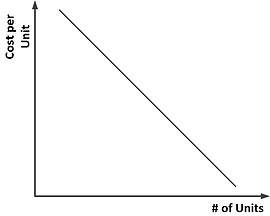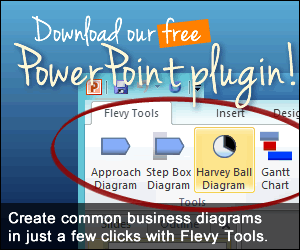The idea of the Experience Curve has been around for over 50 years. While businesses, organizations, and markets have evolved, the Experience Curve concept survives and can be very useful for informing decisions, shaping strategy, and guiding implementation.
The post explores the origins of the Experience Curve, important nuances to consider, and how it can be useful for a strategic project manager.
The Basic Experience Curve Concept
 The figure at right illustrates the basic concept of the experience curve. The idea is similar to the individual learning curve, where an individual, gets better with experience. The difference between the learning curve and experience curve is that the latter applies to organizations.
The figure at right illustrates the basic concept of the experience curve. The idea is similar to the individual learning curve, where an individual, gets better with experience. The difference between the learning curve and experience curve is that the latter applies to organizations.
The experience curve was proposed by Bruce D. Henderson, the founder of the Boston Consulting Group (BCG), based on analyses of overall cost behavior in the 1960s. At the time, it was consistently found across industries that costs would typically decrease by 10 to 25% every time volume doubled.
The decrease in costs typically occurred in aggregate across all costs that could be assigned to the unit cost – administration, marketing, distribution, and manufacturing costs.
While the graph illustrates the general idea that costs decrease as volume increases, there are some caveats:
- The experience curve is not necessarily a straight line.
- Costs do not just keep decreasing. At some point they may even turn upward, as with economies of scope.
Let’s go deeper and explore some additional nuances of the experience curve concept.
Nuances of the Experience Curve Concept That Make a Difference
The slope of the experience curve, or the decrease in cost that results from increased volume, can vary widely from product to product, and industry to industry. While BCG originally identified the 10 to 25% range every time volume doubled, there are other factors to consider, such as:
- Cost reduction does not occur automatically. Psychologically, cost has inertial effect.
- Some products have greater potential for improvement over time.
- Manufacturing costs have the most potential for cost decreases, which are limited for raw materials, marketing, sales, and distribution.
Consider that it can be helpful to look at cost reductions in a more granular manner:
- Labor efficiencies – There is a lot of room for cost reduction through more efficient use of human resources, often outweighing most other factors.
- Standardization, specialization, method improvements – These can bring significant improvements by removing product customizations, or by finding efficiencies in mass customization.
- Technology-driven learning – The evolution of technology has shown that it takes some time to learn to apply technology advances, creating a natural technology-driven experience curve.
- Better use of equipment – As with other technology, experience with the use of equipment usually brings efficiencies and reduction in cost.
- Changes in resource mix – Experience with different combinations of inputs can lead to more optimal and lower cost configurations.
- Product redesign – As with changes in inputs, other design changes based upon learning can lead to reduction of raw materials, decreased waste, more efficient use of machinery, and improvements to the product, which can lead to more sales and increasing volume.
- Network-building and use-cost reductions – These network effects did not even exist in the same way back when the learning curve was first conceptualized.
- Shared experience effects – These relate to augmenting product-centric experiences with alternate experiences using economies of scope.
In a particular situation, one of these factors can decrease costs substantially, or have no impact at all. That is why it is important to identify the key factors and to build an experience curve for each high impact factor.
Another nuance is that the experience curve can be totally replaced with a new curve as markets change and evolve. This is what happens with new and disruptive innovations.
Using the Experience Curve in Strategy Formulation
There are three basic paths to take using the experience curve as a basis for building a viable strategy::
- Strategy of cutting costs – Cut costs as experience is gained and the business moves down the experience curve. This allows for some profits while building scale and a protective moat.
- Strategy of cutting prices – Cut prices earlier to discourage the competition. This takes financial advantages, as there will be intital losses. It also takes strong confidence and conviction about volume growth and cost reduction.
- Strategy of gaining share aggressively – Investing more heavily in marketing and sales efforts can buy market share for early and sustaining advantages, provided the business has financial strength and confidence in forecasts.
The key in choosing the right strategy is to identify the discrete activities performed in delivering the product, similar to looking at the Value Chain, and forecast cost reductions for increasing volumes of each activity over time.
In addition to the cost saving ideas in the prior section here are some other factors to consider:
- Find ways to share costs with other activities and other products to achieve economies of scope.
- With increasing technical experience and customer feedback, focus on improving bargaining power with buyers and suppliers through precision selection of suppliers and buyers, threatening the possibility of vertical integration, and building switching costs.
- Be careful with aggressive pursuit of market share economies of scale unless you have a distinct advantage, such as first mover advantage, that keeps competitors from reciprocal actions.
- Seek sustainable improvements from increased output (ie better design, production efficiencies) in seeking advantage.
Other factors to consider when formulating a strategy based on the experience curve include:
- Poaching of employees and reverse engineering by competitors may compromise confidentiality of cost saving secrets.
- Price reduction at a loss vs reducing prices as costs decrease may reduce competition sooner.
- The industry’s stage of maturity is very important to developing accurate forecasts.
- The product’s stage of development is also a factor in forecasts and investment.
- Sensitivity of market to price level and price changes is a key factor to understand.
- Ability of customers to change or substitute products must be well understood.
Without careful consideration for these factors, competing based on cost is not always the most effective strategy and can lead to a path of low profitability.
The Experience Curve as an Input to Project Management
As a project manager, my first question is, “What level of experience does the team and organization have with the business at hand?” Depending on the answer, there may be a need to plan for time and activities to gain experience in order to proceed with confidence.
—————————————-
I recommend these PM templates (paid link):
—————————————-
The most obvious things to consider from a learning curve strategy execution perspective are the risks. I alluded to some risks above, and here are some additional risks to consider:
- Investing early in the wrong technology can lead to losses and regret later.
- Cutting costs before establishing the product firmly is another problem. Practice lean innovation where appropriate.
- Putting too much investment into a potentially short-lived business is an increasing risk. Build strategic agility and dynamic capabilities.
- Government policies such as taxes, depreciation, interest rates, subsidies are important, but hopefully are not the basis for the strategy, as the business has no control.
- Anti-trust can sometimes be an issue. Ask if the situation could support a natural monopoly, and if that could pose a risk.
- Few strategies will work if financing strength is weak when compared to competitors.
Besides risk management, project, program, and portfolio managers need to be mindful of the timing of projects related to the experience curve, as timing alone can make or break the project.
What benefits do you see in applying the experience curve concept in project management?
Additional Resources
The following resources provide additional background and are easy to access:
Building Strategy on the Experience Curve, by Pankaj Ghemawat, Harvard Business Review, 1985
The Experience Curve, by Bruce Henderson, Boston Consulting Group, 1968
The following are related resources (these are paid links):


